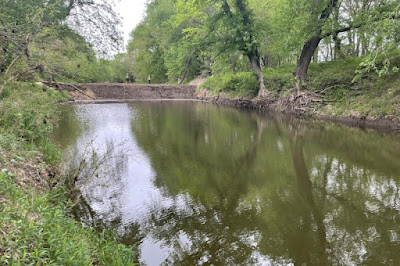The Keystone XL pipeline ruptured on Dec. 8 last year, sending more than 600,000 gallons of crude oil into the environment around Mill Creek, in Bourbon County, Kan.

Almost a year after a pipeline rupture spilled thousands of gallons of crude oil into a waterway in Kansas, the cleanup is now complete, the EPA confirmed Wednesday.
Photo courtesy of Environmental Protection Agency
Nov. 1 (UPI) -- Almost a year after a pipeline rupture spilled thousands of gallons of crude oil into a waterway in Kansas, the cleanup is now complete, the Environmental Protection Agency confirmed Wednesday.
A final visual inspection of the Mill Creek waterway in eastern Kansas took place Oct. 13, the EPA said in a statement.
Both the Kansas Department of Health and Environment and the U.S. Army Corps of Engineers will continue monitoring the site for the next five years with regular inspections.
"Flow and water levels have been returned to natural conditions," the EPA said in the statement.
The bulk of oil recovery was completed by late January with cleanup efforts running 24 hours a day. However, the final steps of that process took until mid May to wrap up, when recovery efforts then shifted to stream restoration.
The Keystone XL pipeline ruptured on Dec. 8 last year, sending more than 600,000 gallons of crude oil into the environment around Mill Creek, in Bourbon County, Kan.
State and federal officials at the time estimated 14,000 barrels of oil were released into Mill Creek. The waterway is located 3 miles east of Washington, Kan., and about 170 miles northwest of Kansas City along the Kansas-Nebraska border.
Ultimately more than 650,000 gallons of oil were recovered, including crude that remained in the pipeline after the rupture.
An additional 200,000 tons of soil, sediment, and other debris impacted by oil were excavated and sent for disposal, according to the EPA.
The accident was the largest rupture in the history of the pipeline, which began operating in 2010.
The system of lines transports crude oil from northern Canada to refineries in Illinois and Texas.
The EPA deployed staff from four regions to help monitor the spill site, working more than a collective 6,000 hours. The U.S. Coast Guard was also involved in the operation.
"In total, more than 54 million gallons of contaminated surface water were treated and discharged back into Mill Creek," the EPA said in the statement
Nov. 1 (UPI) -- Almost a year after a pipeline rupture spilled thousands of gallons of crude oil into a waterway in Kansas, the cleanup is now complete, the Environmental Protection Agency confirmed Wednesday.
A final visual inspection of the Mill Creek waterway in eastern Kansas took place Oct. 13, the EPA said in a statement.
Both the Kansas Department of Health and Environment and the U.S. Army Corps of Engineers will continue monitoring the site for the next five years with regular inspections.
"Flow and water levels have been returned to natural conditions," the EPA said in the statement.
The bulk of oil recovery was completed by late January with cleanup efforts running 24 hours a day. However, the final steps of that process took until mid May to wrap up, when recovery efforts then shifted to stream restoration.
The Keystone XL pipeline ruptured on Dec. 8 last year, sending more than 600,000 gallons of crude oil into the environment around Mill Creek, in Bourbon County, Kan.
State and federal officials at the time estimated 14,000 barrels of oil were released into Mill Creek. The waterway is located 3 miles east of Washington, Kan., and about 170 miles northwest of Kansas City along the Kansas-Nebraska border.
Ultimately more than 650,000 gallons of oil were recovered, including crude that remained in the pipeline after the rupture.
An additional 200,000 tons of soil, sediment, and other debris impacted by oil were excavated and sent for disposal, according to the EPA.
The accident was the largest rupture in the history of the pipeline, which began operating in 2010.
The system of lines transports crude oil from northern Canada to refineries in Illinois and Texas.
The EPA deployed staff from four regions to help monitor the spill site, working more than a collective 6,000 hours. The U.S. Coast Guard was also involved in the operation.
"In total, more than 54 million gallons of contaminated surface water were treated and discharged back into Mill Creek," the EPA said in the statement

.jpg)
.jpg)
.jpg)
No comments:
Post a Comment